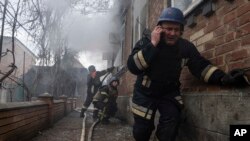Russia’s Wagner Group is in control of the eastern portion of the Ukrainian city of Bakhmut, while Ukrainian forces are holding on to the western part, according to an intelligence update Saturday from the British Defense Ministry.
The Bakhmutka River, which runs through the Donbas city, “now marks the front line,” the update said. Given that Ukrainians destroyed key bridges days ago, the line will be difficult for Wagner forces to cross.
With Ukrainian snipers firing from fortified buildings on the west, the update added, the open ground between the sides “has become a killing zone making it highly challenging for Wagner forces attempting to continue their frontal assault westwards.”
On the Ukrainian side, the Defense Ministry said, their forces and their supply lines to the west remain vulnerable to Russian attempts to outflank them from the north and south.
Yevgeny Prigozhin, leader of the Wagner Group’s mercenaries, posted a video Saturday from what he said was the Bakhmut city center. He again demanded more ammunition from the Russian military to enable his troops to move forward. His location could not be immediately verified.
The Institute for the Study of War, a Washington-based think tank, in its Friday update, reported Russians advancing to within 800 meters of the AZOM metal-processing plant in the northwestern part of the city. Taking the huge facility would likely lead to a “further wave of Russian casualties,” the institute said.
While neither side has disclosed up-to-date casualties, both are believed to be suffering heavy losses — Russia particularly so — in the fighting over a city that the U.S. military describes as having little strategic value.
A NATO report released last Monday estimates that Russia is losing five times as many troops as Ukraine in the battle for Bakhmut.
Moscow has said capturing Bakhmut is a step toward the Russian military seizing all of Ukraine’s eastern Donbas region.
An aide to Ukrainian President Volodymyr Zelenskyy said Friday that Kyiv is using the battle to grind down Russia's best units.
Ukraine has two objectives, Mykhailo Podolyak said in an interview published by Italy's La Stampa newspaper: “To reduce their capable personnel as much as possible, and to fix them in a few key wearisome battles, to disrupt their offensive and concentrate our resources elsewhere, for the spring counter-offensive.”
During its daily briefing, the Ukrainian General Staff said Saturday the Russian military launched “more than 100 attacks” across the front line in the Donetsk region, including around Lyman, Bakhmut, Avdiivka, and Shakhtarsk.
Russia also reportedly carried out 29 airstrikes and four missile strikes in the region over the previous 24 hours, the military said, killing at least five people and injuring 19 in the Kherson and Donetsk provinces. Three civilians were killed and two injured in the city of Kherson when a Russian shell struck their car, Oleksandr Prokudin, the head of the Ukrainian military administration in the southern Kherson region, said.
The reports could not be independently confirmed.
Work continued Saturday to restore damage from a Russian missile and drone strike Thursday that killed six people and left hundreds of thousands without heat or electricity.
Ukrenergo, Ukraine’s grid operator, said power supply issues persisted across four provinces. Scheduled blackouts remain in place in Kharkiv and Zhytomyr, as well as parts of the Dnipropetrovsk and Mykolaiv regions, it said in a Facebook post.
Norway is showing its support for Ukraine for the long haul. Defense Minister Bjorn Arild Gram announced Saturday that over the next five years, Norway would send $7.5 billion in weapons and other aid for Ukraine, including missile launchers and ammunition for NASAMS anti-aircraft systems.
Some information in this report came from Radio Free Europe/Radio Liberty, The Associated Press and Reuters.













